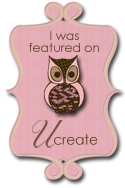This is a fun experiment to do with your children. I am adding a colorful twist in honor of Easter. If you want to do this for Easter, you need to start this experiment a week ahead of time.
What you will need to start:
White Vinegar
Food coloring (optional)
2 cups or a jars (I use jars because I can close the lid so I won't smell the vinegar all week)
Water
At least 2 Raw Eggs (For this example I use 1 egg for the water soak and 2 eggs for the vinegar soak (one for each of my boys)
Step 1: In one jar fill with enough water so that the egg will be completely covered. For fun stir in some food coloring to the water (optional). Carefully place the egg in the water. If using a jar close the lid. Label the jar "Water." Now set it aside.

Step 2: In the other jar fill it with enough vinegar so that the egg will be completely covered. For fun stir in some food coloring (optional). Carefully place the second egg in the vinegar. If using a jar close the lid. Label this jar "Vinegar."

This is my vinegar jar with food coloring added. The food coloring is a new addition to this little experiment. It is fun to see how a simple change like food coloring will effect the end product. Will the egg take on color by the end of this?

Step 3: Observe both jars with your child. Do you see a difference? Ask your children what they think is happening. Check back in a couple of hours. Is there any change? The above picture shows a reaction starting to happen as soon as the eggs are in the vinegar, even before I have a chance to add food coloring.
Step 4: Put both jars aside for 1 week. Repeat step 3 in a day or two.
Step 5: After the eggs have sat in the vinegar for a week, observe with your children the eggs while in their jars. What has happened? Do they look different?
Before you take the eggs out you will need to get two bowls to bounce your eggs in. I suggest you don't do this over carpet, just in case.
Step 6: Remove the eggs from the jars. Go ahead and rinse them off. Now take the eggs into a dark room and shine a flashlight at them. What do you see? The light bounces off the vinegar egg, doesn't it? What about the other egg?
Step 7: Look closely at the eggs with your child. What are the differences? Did one take on more color than the other? Do they feel the same? Do they look the same? What changed, besides the color?
Step 8: Hold the eggs a short distance above the bottom of the bowl. Start with dropping the eggs a short distance. (Be sure to drop the egg and not throw the egg. Small children will have to be helped with this one. They will not know the difference between dropping and throwing. Trust me on this one.) What happened with the egg that was in the vinegar? What happened with the egg that was in the water? What was the difference between them?
Step 9: Hold the egg a little higher each time you drop it. How high can you drop it from before it breaks? Yes the egg will break eventually. Thus the reason for the bowl and not over carpet.
How does it work?
The acid in the vinegar dissolves the calcium carbonate that is in the shell.
What has happened is called a chemical reaction. The acid (vinegar) reacts with the calcium carbonate of the eggshell. The reaction makes the shell go soft, then disappear. This is called "decalcification".
The water is not acidic and will not dissolve the calcium in the shell. It remains unchanged (not edible but unchanged)
I didn't want to post pictures of every step. I want you to see what happens for yourself. Even though I have given a bit of the ending away you will still have a ball with this one. ;)
Thinking of Papa (my Father-in-Law) and his corny jokes makes me smile.
More vinegar fun: You can make chicken bones soft too. You can make them soft enough to bend. Put a clean wishbone or leg bone into a jar of vinegar. Make sure the bones are completely covered. Leave them alone for 7 days. The bones will go soft enough to twist them into a knot. The vinegar reacts with the minerals in the bones that make them strong and rigid. The vinegar will dissolve the minerals like it did with the calcium in the egg shell.
Who says science can't be fun?
My boys really love science experiments. They had a lot of fun with this one and yes we are soaking chicken bones as we speak. The first time we only did one egg in the vinegar. When it came time to bounce the eggs, it was over far to quick for them. They were ready to start the process all over again. The second time around we skipped the egg in the water. What we really wanted was to bounce the egg. My youngest got a little over excited when it was his turn to drop the egg. He ever so slightly threw the egg (not quite a throw and not just a drop). The force was enough to make the egg splat before we could get very many bounces out of it. For this reason I highly recommend you put two eggs in the vinegar jar (especially if you have more than one child). Not to mention you will have fun as well. I found I was just as excited to see the results as they were the first time. This experiment is just one of many that my boys have enjoyed. I hope you try this and I hope you add food coloring for a ramp up to Easter. I didn't stress the chemistry lesson here for my boys. I asked them questions to make them think a little and they asked me a whole bunch of questions about what happened and why it worked. I let their curiosity be my guide.
I also must warn you. My oldest wanted to keep the bouncy egg and to put it away with his toys. So watch that the eggs don't go missing. I explained that the egg would not last forever and that it would make a mess of his toys when it broke.
Katrina


 This is my vinegar jar with food coloring added. The food coloring is a new addition to this little experiment. It is fun to see how a simple change like food coloring will effect the end product. Will the egg take on color by the end of this?
This is my vinegar jar with food coloring added. The food coloring is a new addition to this little experiment. It is fun to see how a simple change like food coloring will effect the end product. Will the egg take on color by the end of this?


































































6 comments:
That sounds like a fun experiment! I was a science/math nerd myself, so I love that stuff. :)
- Cesia.
Where was this post back in January when I was going nuts trying to think of a science fair experiment?? This sounds like a lot of for for my 3. We will definitely have to try this.
This is so cool! :)
tina
Oh, this is neat. Thanks!
I've just found your blog and I think it is great - full of good ideas. We're going to try the egg experiment and I do, now you mention it, vaguely remember making bendy chicken bones 30 years ago when I was young.
Here, in exchange for your great ideas are my family's ideas for things to do with vinegar.
Usually we just mix it with bicarbonate of soda to make fizzy things:
*volcanoes in the sand pit - put a bottle containing some bicarb in the sand pit. Build the sand up around it to make it look like a mountain then add vinegar and let it erupt.
*rockets - you put vinegar and bicarb in a film canister (remember them)and place the film canister with the lid on the floor - you have to be quick. The gas forces the lid off and the canister flies upwards. The first time we did it we did decorate the canister as a rocket but we 've been happy with plain ones since then. Someone suggested vitamin pill tubes might work if you no long have film canisters.
And sometimes I boil up a few red cabbage leaves in water and use the resulting red liquid with vinegar. The red cabbage water changes colour when you add acids or bases to it. So you can make:
*make magic potions by adding vinegar / lemon juice / bicarb of soda - the liquid changes colour and fizzes!
*make magic paintings with it. Paint the red liquid all over absorbent paper - coffee filters, water colour paper, cheap craft paper and thenlet the paper dry. Then let the children paint with vinegar, lemon juice, bicarb dissolved in water and watch the colours change.
Thanks Whatsonox for your comment.
Great minds think alike. I actually already have plans to post many of the things you talked about.
Stay tuned, you can be sure I will be posting about more fun experiments.
Katrina
Post a Comment